Food insecurity and hunger are some of the most prominent issues that plague our modern society. In the U.S., 41 million people, or 12% of the population, struggles with hunger. Researchers also estimate that 23% of households struggled with food insecurity in 2020—a number that more than doubled from the previous year due to the economic impacts of the pandemic.
Food banks work hard to fight against increasingly pervasive hunger in our communities. If your nonprofit is looking for a way to contribute, consider hosting a food drive.
Just like with any other type of fundraiser, food drives require lots of planning. Yes, you’ll need an efficient way to process donations and facilitate the collection of food drive items. However, getting your supporters to show up and participate in your event is only possible with a well-devised branding and design strategy.
Are branding and design really that vital to the success of a fundraiser? Whether you’re planning an in-person, virtual, or hybrid food drive, the answer is yes. In fact, a virtual food drive relies even more on the functionality and design of your website and online branding. Take a look at the statistics:
- 75% of young donors are turned off by out-of-date websites, making them less likely to donate.
- Donors are 34% more likely to give on a responsive website.
- Donations made on a branded donation form are, on average, 38% larger than contributions made through a generic PayPal page.
- Donors are almost 70% more likely to give a second donation if they used a branded donation form the first time they made a contribution.
By marketing your event well, not only will your donors take part in your food drive, but you’ll also attract fresh faces that have the potential to turn into long-term supporters.
Not sure where to start when it comes to marketing your food drive event? Here are a few ideas to make designing your drive a breeze.
Tie your campaign together with food drive theme ideas
When you begin planning your food drive, first think of ways to make your food drive engaging for your donors.
- Matching campaign. Find a partner for your campaign in a business or individual who is willing to match donations made to your drive dollar for dollar. The impact of your event will double, and people will be more excited to donate when they know their donations will be matched. Check out WXII 12’s Giving Tuesday Virtual Food Drive for a great example of a matching campaign.
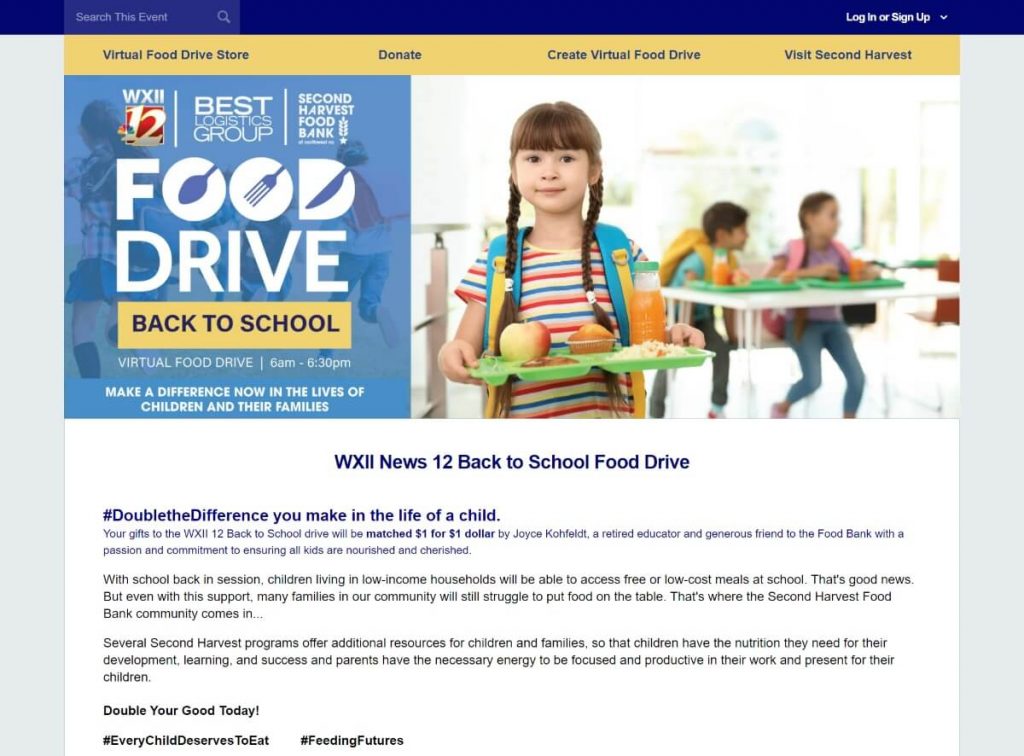
- “Skip a Meal” campaign. Challenge your donors to participate in a “Skip a Meal” challenge. Rather than spending money on Thai food takeout or heading to the grocery store to grab the ingredients for Taco Tuesday or Spaghetti Saturday, encourage your supporters to donate the money they would’ve spent on a special meal to your food drive.
- Peer-to-peer campaign. Engage your donors with a little friendly competition. Set up a peer-to-peer fundraising page, complete with a thermometer to track how much money your food drive has raised. Offer a team fundraising option so participants can go head-to-head to see who can raise the most money.
- Virtual pantry drive. A virtual food drive may seem like a strange concept, but pandemic-proofing this classic food fundraiser is easier than it may seem. Take it from The Sharing Center who hosted a virtual pantry drive that simulated the experience of shopping in a grocery store, but online.
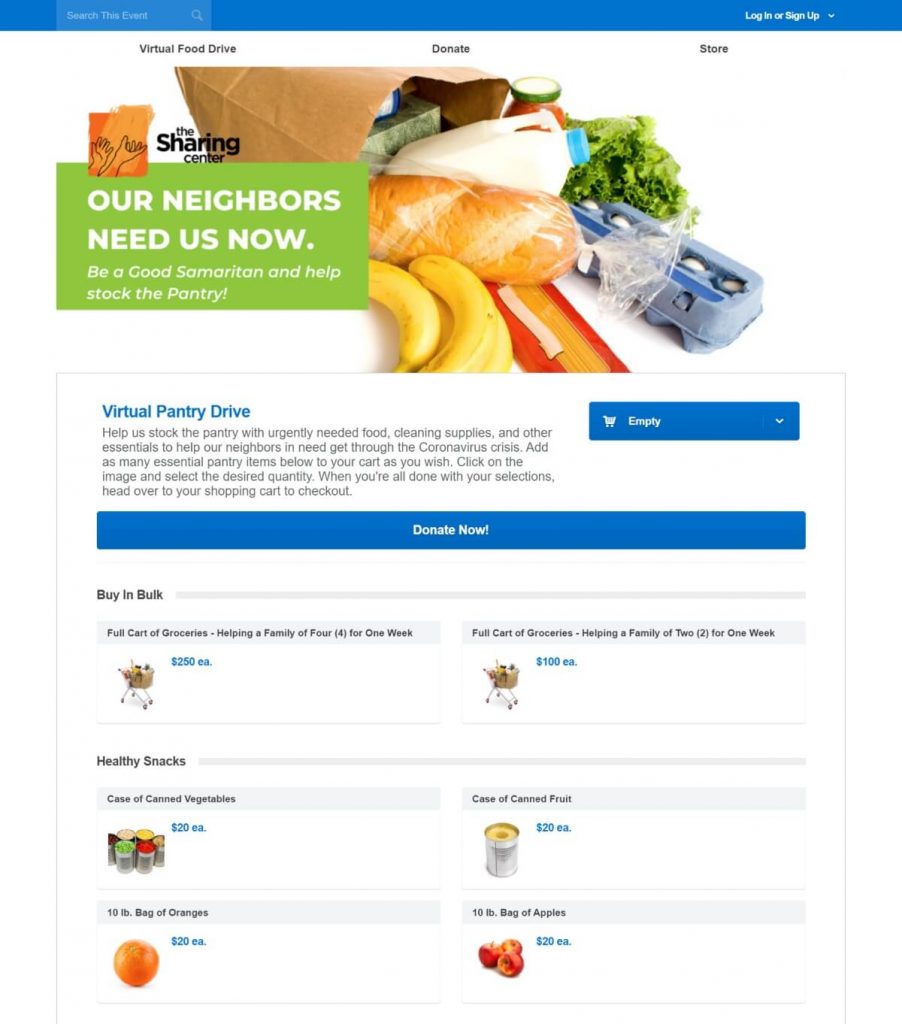
- Most needed items. If there’s a shortage of specific goods in your area, consider theming your food drive after the items you want to collect most. If you have plenty of perishables but need canned food that keeps longer, advertise your event as a canned food drive. When Thanksgiving rolls around, there may be people in your community in need of a turkey for their tables. Collect frozen turkeys from your supporters for this holiday-specific food drive.
- Team up with a local organization. Hosting a joint food drive with another organization can significantly increase the impact of your event. You’ll be able to tap supporters of your partner organization to contribute to your food drive in addition to your own, bringing in more donations and new faces. Check out the Greater Pittsburgh Community Food Bank’s 2020 “Scouting for Food” event, where the food bank teamed up with the local Boy Scouts of America Council to host their annual food drive.
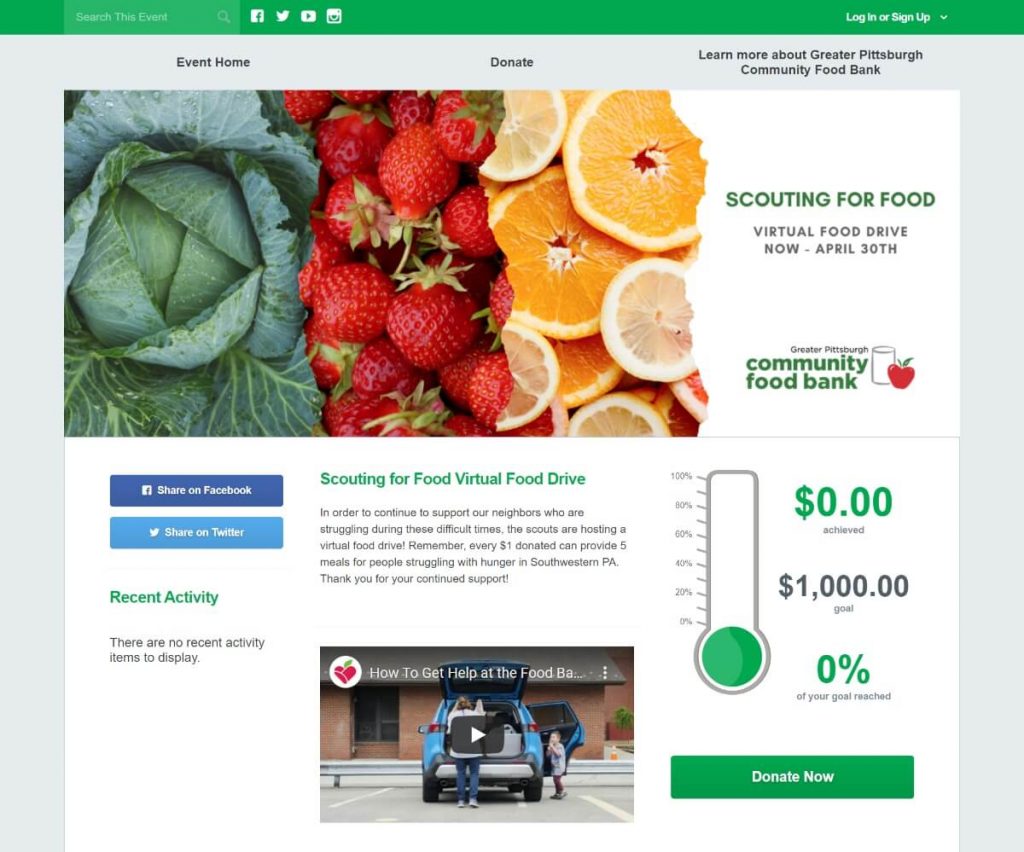
Create a memorable food drive slogan
After you’ve decided what your event theme will be, an excellent way to make your event memorable for your supporters is to create a slogan or tagline for your food drive.
A short, catchy expression will stay with anyone who sees marketing for your event. Try to come up with a slogan that is informative without being overbearing. Brevity is key—you’ll want your tagline to get to the point quickly. However, as short as your slogan should be, don’t sacrifice clarity. Your slogan should convey the value and vision of your event with only a few attention-grabbing words.
Partner with corporate or media organizations
Struggling to get the word out about your food drive event? While your email contact list and website are great advertising tools, you’re probably only reaching your existing donors and supporters that way.
Expand your reach by partnering with a media organization and advertising your event through external channels. Pitch your event to your local news or ask them to become a sponsor for your food drive. You’ll be able to take advantage of their viewership to promote your food drive and bring in new supporters.
Need help planning your next virtual event? Download our Virtual Event Planner to boost your fundraiser’s success!
Create your food drive logo
Your nonprofit’s logo is the center of your brand. It makes you recognizable, and it communicates your identity and values to your supporters. When you organize a fundraiser, you want a logo that does the exact same thing, but for your event.
- Keep it simple. Your event logo should do the same thing as your slogan but through pictures instead of words. Keep the design clean, and use it to create a visual representation of your event.
- Incorporate your nonprofit’s color scheme for consistent branding. When people see the marketing for your event, you want to make sure they know it’s your nonprofit’s event. Do this by incorporating your nonprofit’s color scheme into your event’s branding. Use this color scheme consistently across your logo, posters, and web pages. Check out the Northern Illinois Food Bank’s online fundraiser if you need inspiration for how to keep your event’s branding consistent with your organization.
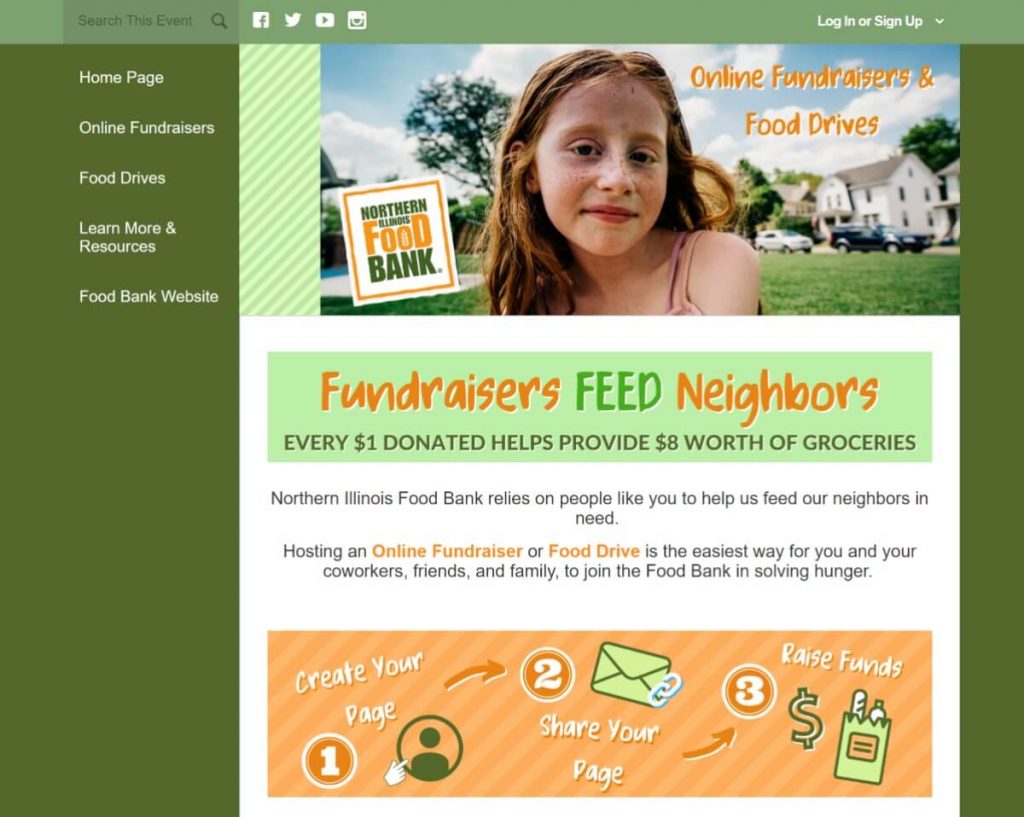
- Make sure your branding is consistent with your national organization’s branding. If your nonprofit is part of a larger national organization, it’s essential to ensure your event’s branding is consistent with your national organization’s branding guidelines. If they have specific rules about how to use color schemes and visual assets, follow them as you’re advertising your event.
Creating a logo isn’t always easy on your own. If you don’t have on-staff design or a design vendor, here are a few resources to turn you into a logo-designing pro in minutes:
- Wix Logo Maker
- Tailor Brands
- Looka Logo Maker
- SmashingLogo
- Shopify’s Hatchful
- Canva
- Adobe Illustrator
Create your nonprofit branding guide
As you continue planning and hosting fundraisers, it can be useful to have a guide to reference as you create assets for your nonprofit’s events. List out preferred colors, fonts and font sizes, tone, preferred logos, and other design elements so anyone planning an event for your nonprofit can easily put together marketing materials. Instead of having to continue to look back at old events and trying to remember specific fonts and color codes, you can simply open up your guidebook.
Not only does a branding guide take the guesswork out of future designs you may create, but it’ll also keep your branding consistent across events, solidifying your nonprofit’s identity. When people see posters and other advertising, they’ll instantly be able to recognize that it’s one of your events.
When you include icons and imagery in your branding guide, try your hand at design using Canva or other online resources instead of constantly pulling from pre-made clip art. Your events’ advertising designs will be unique to your nonprofit, helping them stand out.
Create your fundraising event page
Creating an event page means your donors will always have a place online to go to when they have questions or need information about your event. This will be your event’s online home, especially if you’re hosting a virtual food drive, so it’s important to design this site so it’s engaging and helpful.
Make instructions for your event useful and compelling, and predict what questions your donors need answers for, like:
- Are you accepting physical donations?
- Where can physical donations be dropped off?
- What kinds of items are you looking for?
- Are there certain things you can’t accept?
- Why should I consider donating money instead of food?
- If I make a financial donation, what will it achieve?
- Where do I go to donate?
All of the information you’re providing should be easy to find and easy to understand. To answer all of your donors’ commonly asked questions, consider adding an FAQ section to your website.
As for design, keep the branding for your event page in line with the branding donors are used to seeing from your nonprofit to reinforce trust and increase participation. Use lots of images to show your nonprofit’s impact on the community you serve. Pictures are the perfect storytelling tool, and they will help your donors feel more connected to your cause.
Similar to photographs, videos are also an essential design element for your website. Studies show that 57% of people who watch nonprofit videos go on to make a donation. And while it may seem costly to produce videos, you don’t need to hire a professional film crew when you have a smartphone.
Use gamification tools to increase engagement
Turning your fundraiser into a game can motivate your donors to participate in your food drive and keep them updated on the status of your fundraising efforts.
Setting goals can give your supporters a solid idea of what they should be striving for and also provides a feeling of accomplishment when your goals are achieved. Use a fundraising thermometer on your website to help your donors visualize their goals and how far along they are in reaching them.
If your fundraiser is a peer-to-peer campaign, use leaderboards and badges to personalize your food drive’s gamification. Leaderboards can display individuals and teams that have contributed the most to your fundraiser, driving your donors to continue participating in your event. Personal badges can be awarded to donors as they continue participating in the fundraiser. As your donors achieve their goals, send emails thanking them for their hard work and congratulating them on meeting their goals.
Make good use of your confirmation pages and receipts
Your nonprofit’s donation receipts are more than just your regular record of a financial transaction. Your donors need a donation receipt for their taxes, so donation receipts are semi-permanent records your donors will keep in their files for a while.
Beyond the tax information your donor needs for their records, you can also add customizations to your donation receipts. Use your confirmation pages and receipts as an opportunity to thank your donors for the contribution they made. If your donor made a special contribution in the form of a monthly gift or if they gave extra to help cover processing fees, you can add conditional content to thank them for going the extra mile. And don’t forget to add impact statements to show them how their gift will make a difference.
Get ready to promote your fundraiser
You want to attract as many donors as you can to participate in your fundraiser. Promoting your fundraiser will not only help you connect with your existing supporters, but you’ll also be able to expand your reach to new donors.
Begin with the basics—adding your event to your website. Place an advertisement for your event at the top of your home page in a featured area, like your website header.
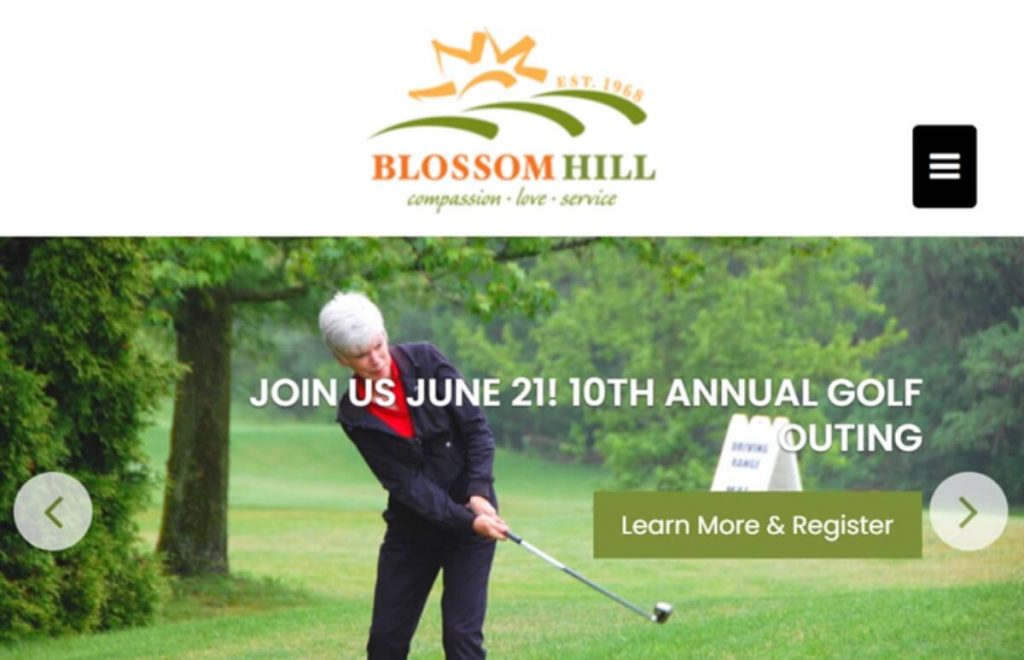
Then, start advertising across all of your available online channels. Utilize your email and text lists, putting together campaigns to send save-the-dates and regular reminders. Post on your social media channels, and if you have the budget, pay to boost those posts as advertisements across those social media platforms.
Have a retention strategy for new donors
When you bring new supporters into the fold, it’s vital that you nurture your relationship with them to build trust. Make it easy for them to get to know your nonprofit and how they can contribute to your mission.
First, always thank your new donors for their contributions. Share stories of your nonprofit’s impact on the community, and tell them what their gift means to you and the people you serve. Send information on how they can stay directly connected with your nonprofit via social media, and give them options for how to stay involved through volunteer opportunities or with additional ways to give.
Consider starting an email welcome series to introduce your new donors to your nonprofit. Start by designing your emails to be friendly and engaging, as well as informative. Use personalization tags to speak directly to your donors and make them feel welcome. Then, determine how many emails you’ll be sending and how often. You don’t want to bombard your new donors with incessant emails, but you need to send enough that your nonprofit stays relevant to your donor.
Curious about how to host a dynamic and engaging peer-to-peer fundraising event? Request a demo today.
Final thoughts
Designing and marketing your food drive well will help you mobilize your supporters to bring in more resources and money so you can better serve your community. If you need more resources to plan a successful food drive fundraiser, check out these pages:


